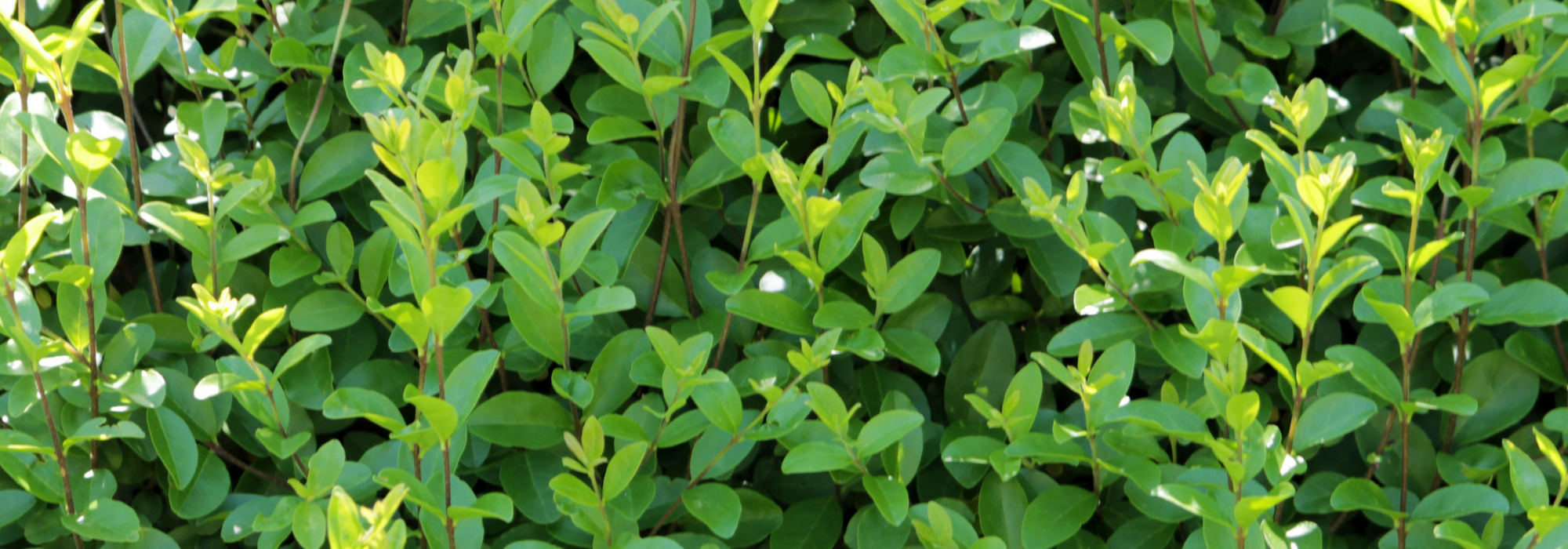
Privet, Ligustrum: planting, pruning and care
Contents
The Privet, in a nutshell
- Privets form small bushes or large, fast-growing bushes.
- They are evergreen or semi-evergreen, offering not only their glossy dark green hue but also various variegated forms.
- They are well-suited for small gardens as hedges or as a backdrop for flower beds.
- Privets lend themselves well to repeated pruning and can be used to create topiaries or even bonsais.
- Very hardy, they tolerate all types of well-drained soils, including calcareous ones, full sun as well as partial shade, and are resistant to pollution.
A word from our expert
Privet, Ligustrum in Latin, is a bush or small tree often used to create hedges. Fast-growing, low-maintenance, and easy to cultivate in any soil that is not too dry, it tolerates repeated pruning very well. It can also be planted in shrub borders and grow freely. It deserves more frequent use as a standalone specimen, pruned or in free form, or within borders. The foliage, along with the flowering and fruiting in the form of shiny black berries, are all attractions worth exploiting.
There is a wide variety of foliage, deciduous or evergreen, always lush, glossy, and of fairly modest size, so that privet can fit into both a shrub border and a perennial bed, in a rockery, in a low or medium hedge, or even in a terrace or balcony setting. To brighten a dark area or draw the eye, there are variegated forms like Ligustrum ovalifolium ‘Aureum’ as well as more subtle forms with green foliage that light up throughout the seasons, such as the cultivar ‘Lemon Lime’ or Ligustrum vicaryii.

Privet foliage: Ligustrum ovalifolium ‘Aureum’, Ligustrum japonicum, Ligustrum x ‘Vicaryi’, Ligustrum vulgare ‘Atrovirens’, Ligustrum ibota ‘Musli’.
Their flowering, which can be more or less spectacular depending on the species, is always melliferous, unique with its honey scent, attracting many pollinating insects such as butterflies and bees. The presence of privets in the garden thus encourages biodiversity, as they are also attractive to birds in autumn, providing them with shelter and cover.
Ligustrum lucidum is a fast-growing tree species that tolerates drought well and makes an interesting small evergreen shade tree in Mediterranean regions. It self-seeds readily due to its abundant fruiting.
Description and Botany
Botanical data
- Latin name Ligustrum sp.
- Family Oleaceae
- Common name Privet
- Flowering depending on varieties, between April and September
- Height between 1.5 m and 6 m
- Sun exposure full sun or partial shade
- Soil type all types of drained soils
- Hardiness Excellent to average
Primarily native to Asia, the genus Ligustrum can also be found in Europe, North Africa, and even Australia. It comprises nearly 50 species, most of which selected for gardens (japonicum, ovalifolium, sinense, lucidum, obtusifolium) are of Asian origin, particularly from Japan, China, and Korea. Only the species vulgare is native to Europe, but its range extends into temperate Asia and North Africa.
Privets belong to the Oleaceae family, just like the Olive, Ash, Forsythia, and Jasmine. Ligustrum lucidum forms a tree up to 15-20 m tall in the wild, while most other cultivated species are shrubs ranging from 1 to 3 m tall at maturity and tolerate pruning well.
Among the remarkable features of the genus Ligustrum, one can note the entire, opposite leaves, oval or obovate (wider at the upper part of the lamina), with a very pronounced central vein. The glossy leaves are evergreen in Japanese privet (Ligustrum japonicum) and Chinese privet (L. lucidum), semi-evergreen (evergreen in mild climates) in common privet Ligustrum vulgare, California privet (L. ovalifolium), and L. sinense, or strictly deciduous in other species.
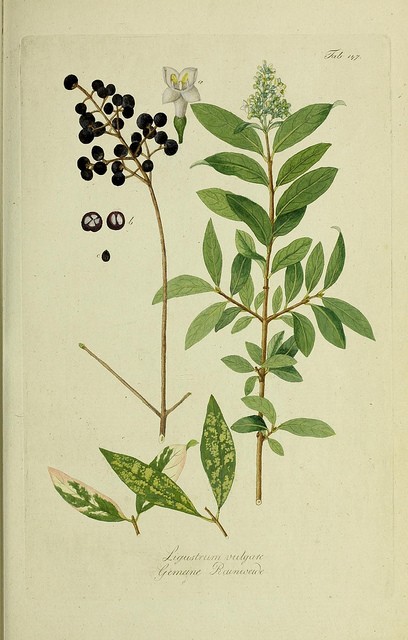
Ligustrum vulgare – botanical illustration
They measure between 2 and 10 cm long. L. vulgare ‘Lodense’ is a form with fine semi-evergreen foliage that turns bronze in autumn. It is highly valued in low hedges or topiary as it grows slowly and creates lovely domes of 1 m high. The leathery, well-rounded leaves of L. japonicum ‘Rotundifolium Aureum’ are dark green edged with gold and take on a lovely green and pink hue in spring and autumn. L. japonicum ‘Texanum’ has wavy leathery leaves, while Ligustrum ibota Musli features particularly bright cream variegated foliage.
The tubular flowers grouped in more or less abundant inflorescences, 2 to 15 cm long, have 4 fused sepals, 4 waxy petals, 2 stamens that disperse abundant pollen, and a bifid pistil. The flowers are generally cream-coloured but have a hint of purple in Yunnan privet (L. delavayanum). The species sinense is particularly attractive during flowering with its weeping habit and long fragrant white clusters. Be cautious, as the pollen can be allergenic for some sensitive individuals. As privet flowers on the current year’s wood, it is advisable to prune just before the clusters open.
The clusters of dark purple fruits stand out against the foliage in autumn and winter. These are small stone fruits, about 1 cm, toxic to humans and pets but highly appreciated by birds, which find both shelter and food in them.
The root system of privets is quite dense and running, making it difficult for other plants to grow at their base. Once well established, privet is capable of withstanding periods of drought, although it prefers moist soil.
The genus name for privets is Ligustrum, derived from the Latin ligare, meaning “to bind,” in reference to its flexible stems that were used for making ties.

Flowering and fruiting of privets: Ligustrum japonicum ‘Rotundifolium’, Ligustrum ibota ‘Musli’, Ligustrum ovalifolium, Ligustrum vulgare ‘Lodense’.
Read also
Which shrubs to replace boxwood?The main varieties
Privet is a more diverse genus than it seems. This bush, essential for structuring the garden, comes in many species and varieties. Of the approximately fifty species of privet, the most common are Ligustrum japonicum and ovalifolium, often used to create hedges. Privet indeed produces hardy decorative hedges, which are very easy to maintain, more ecological than conifer hedges, with a generally fast growth and good tolerance to pollution.
Less vigorous cultivars and certain species like Ligustrum delavayanum are perfect for decorating a container. The latter has small, shiny green foliage that is very dense, allowing you to shape its silhouette into a ball on a stem or other forms, and to create bonsais. Individually, their evergreen or semi-evergreen foliage, variegated with gold or cream, serves as a focal point to highlight flowers, a staircase, or a statue, especially if you shape them into topiary.
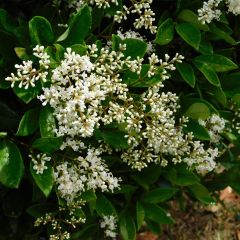
Ligustrum japonicum - Japanese Privet
- Flowering time August to November
- Height at maturity 2,50 m
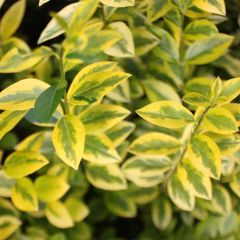
Golden Privet - Ligustrum ovalifolium Aureum
- Flowering time July to September
- Height at maturity 2 m
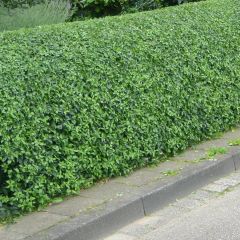
Common Privet - Ligustrum vulgare Lodense
- Flowering time July to September
- Height at maturity 1 m
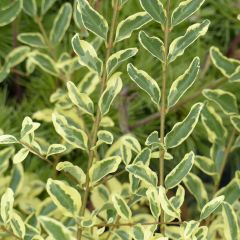
Ligustrum ibota Musli - Privet
- Flowering time July to September
- Height at maturity 2,20 m
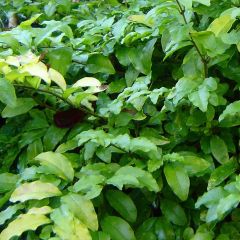
Ligustrum ovalifolium Lemon and Lime - Garden Privet
- Flowering time July to September
- Height at maturity 1,70 m
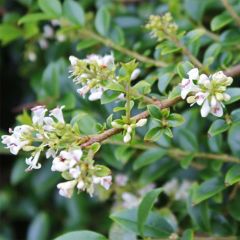
Ligustrum delavayanum - Privet
- Flowering time June to August
- Height at maturity 1,80 m
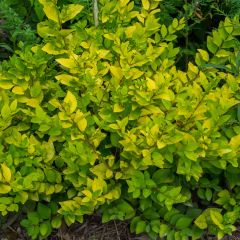
Golden Privet - Ligustrum vicaryi
- Flowering time July to September
- Height at maturity 2 m
Discover other Ligustrum - Privet
View all →Available in 2 sizes
Available in 3 sizes
Available in 2 sizes
Available in 1 sizes
Available in 1 sizes
Available in 1 sizes
Available in 7 sizes
Available in 1 sizes
Available in 5 sizes
Available in 1 sizes
Planting
Where to plant privets?
Privets are not demanding in terms of soil; they accept all types of well-drained soils, including calcareous or salt-impregnated ones. Plant them in a preferably sunny area to ensure compact foliage and more intense colour, although partial shade is also suitable. Variegated foliage expresses itself more in the sun but can also help brighten partially shaded areas.
Note that this bush has a very high resistance to pollution, making it valuable in urban gardens, as well as to sea spray.
The species japonicum is quite common in Europe as well as North America, but only in regions with mild winters, just like lucidum and sinense. The Yunnan privet (L. delavayanum) is also somewhat fragile and should be placed in a sheltered spot away from biting cold. Ligustrum ovalifolium, on the other hand, is much hardier (-28°C) and tolerates calcareous soil very well.
When to plant?
Although it is possible to plant privets sold in pots at any time of the year, ideally, it is best to do so from October until March or April. Avoid planting during frost, extreme heat, or when they are flowering. Plant fragile species in spring after the last severe frosts, if possible.
How to plant?
Avoid planting privets too close to other plants, especially perennials, as they compete strongly for water and nutrients. However, by maintaining a distance of 0.80 to 1.50 m from other bushes, you can easily create a free hedge or a shrub bed with other deciduous species.
Space the plants 60 cm to 1 m apart to form a hedge of privets 1.50 to 2 m high. Bring closer together less vigorous forms like L. vulgare ‘Lodense’ or japonicum ‘Rotundifolium Aureum’, which only spread to about 1 m in diameter.
When planted alone, allow a space of 2 to 4 m depending on the species to highlight the silhouette. Specimens grown on a trunk or compact forms like Ligustrum japonicum ‘Rotundifolium’ are beautiful specimens for solitary planting, in rockeries, or in pots.
To plant a privet:
- Soak the root ball in a bucket of water to thoroughly moisten it.
- Dig a planting hole 50 cm in all directions.
- Add well-rotted manure or compost.
- Place the plant in the planting hole.
- Replace the soil and lightly firm it down.
- Water.
- Spread a layer of mulch at the base to maintain good moisture around the roots. This will also limit the growth of weeds.
The recovery is easy and quick and requires little maintenance.
For pot cultivation, place a drainage layer of 3-4 cm at the bottom of the pot (gravel, broken pottery, etc.). Add a mix consisting of 1/3 soil, 1/3 potting compost, and 1/3 coarse sand.
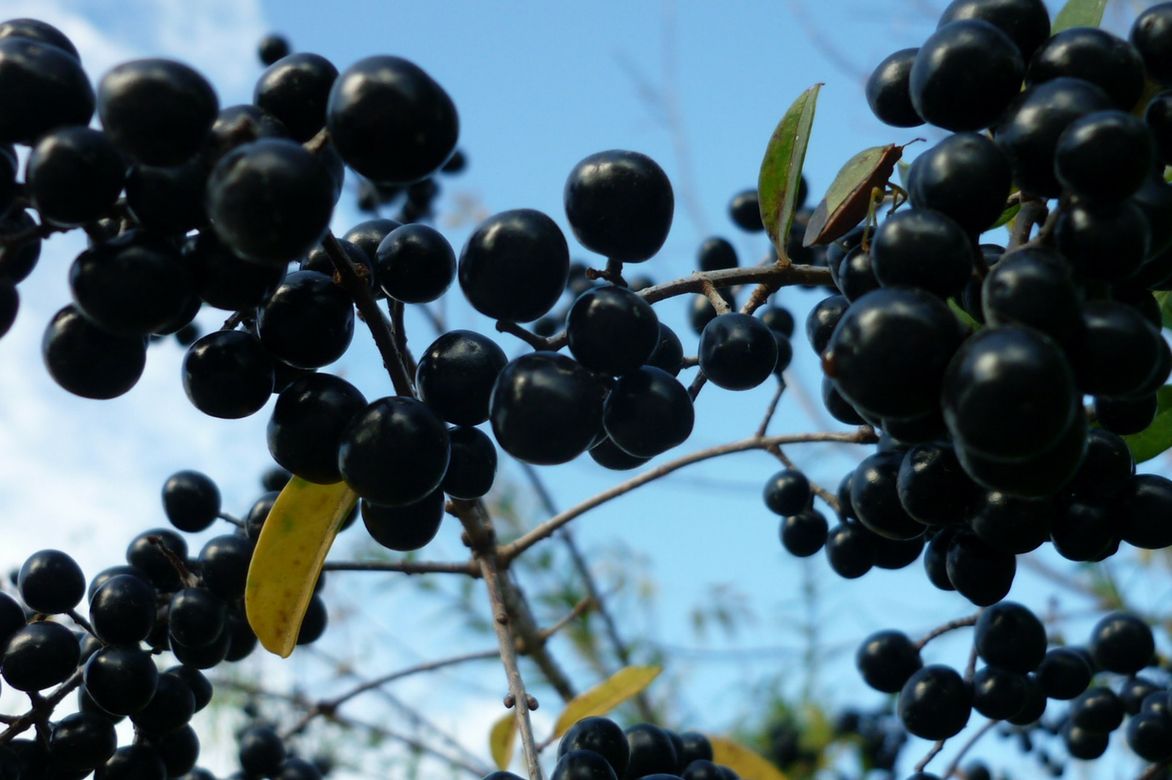
Privets produce decorative berries that are appreciated by birds.
Read also
Be attentive to evergreen bushesThe maintenance and pruning of privets
Maintenance
To maintain a beautiful appearance for your privets:
- Renew the addition of compost or manure every year in spring or as early as autumn.
- From February to April and from July to September, before the resumption of growth and flowering, prune away any diseased or dead wood and any wayward or entangled branches to maintain a good habit and encourage the arrival of new shoots.
- Cut back the branches by half to achieve a denser hedge. This is a bush that tolerates repeated pruning well.
- Protect the species japonicum with a double layer of winter protection if the winter is harsh.
Pruning
- Slow-growing species like Ligustrum japonicum ‘Texanum’ are pruned once a year compared to the type species which may require 3 times a year. You can prune in August or at the end of winter as the flowers form on the wood of the year.
- When flowering is not essential, light pruning aimed at maintaining the shape of a topiary can be carried out at any time of the year.
- Use an electric hedge trimmer, shears, or bonsai scissors depending on the scale of the task. The wood of privet is easy to prune as it is neither too hard nor too thick.
- To thicken a newly planted hedge, cut back the plants with pruning shears to 30-40 cm above the soil and then again 2 more times during the year, leaving a shoot of 30-40 cm each time. The more often you prune your hedge, the longer the leaves will persist before the arrival of frost.
- Remember to regularly check variegated privets to remove any potential appearances of green shoots, signs of a “reversion to type”.
Possible diseases and pests
There are relatively few parasitic attacks on privets. However, they are sometimes susceptible to powdery mildew, a fungus that manifests in dry conditions, especially on newly planted bushes. Powdery mildew appears in early spring or late autumn as white powdery deposits on the leaves, which eventually fall off. Apply a sulphur-based fungicidal treatment at the onset of the attack, repeating every 10-15 days. During prolonged dry spells, remember to water deeply at the base of each bush, forming a basin if necessary. Prune the branches and surrounding plants to promote air circulation.
If the leaves show notches, there is no need to worry, it is adult weevils feeding. You can collect them in the evening by the light of a lamp. These 9 mm greyish-brown striped beetles are identifiable by their long snouts. The larvae, on the other hand, pose a real threat to young plants raised in nurseries. They attack the roots and collar during winter. In this case, water the soil with a biological solution of Heterorhabditis nematodes that parasitise the larvae.
If you observe brownish galleries and leaves clustered in the form of cocoons, it is the lilac borer. The caterpillar of this butterfly feeds on the internal tissues of the leaf. Manually remove the cocoons and, depending on the severity of the attack, apply a biological solution of Bacillus thuringiensis to the foliage, which will kill the young caterpillars.
Multiplication: propagation by cuttings
Propagation by cuttings is the most commonly used method to multiply privet.
They are propagated in spring or autumn.
To begin, prepare a deep pot by filling it with potting soil mixed with sand, or carry out your cuttings in the open ground if it is light, after aerating it with a fork, then moistening it.
In autumn:
- Take a lignified shoot about ten centimetres long from a shoot of the year, being careful to pull it out at the level of a branching to take a “heel” (the end of the bearing shoot). It should be healthy and free from diseases.
- Remove the leaves near the base of the cutting, and trim the others to reduce the foliar surface. Leave only a few leaves at the top if they have not fallen off.
- Autumn cuttings can be done directly in place or in a nursery, possibly protected by a frame.
- Insert the cutting to a depth of 1/3 of its height and gently firm the soil around it to eliminate air pockets and ensure good contact between the potting soil and the cutting.
In spring:
- Take shoots that have both old and new leaves.
- Remove the leaves from the lower half of the cutting and trim 2/3 of the lamina from each leaf.
- Bury half of the cutting in the pot and keep the substrate moist.
- Cover with a plastic sheet held in place by stakes and an elastic band around the pot, in a warm and bright location sheltered from direct sunlight.
- After about 1 month, roots will have formed and you can transplant the young plants.
Usage and associations
Providence for gardeners in need of inspiration, valuable for adding a precise, orderly, reassuring note to the structure of the garden, the privet has at least the advantage of bringing a touch of lushness and life to neglected areas, and why not to abandoned edges.

A hedge of Ligustrum vulgare ‘Atrovirens’ adds structure to the garden.
The main use of privet is for creating screening and windbreak hedges, due to the density of its bright foliage, its medium stature, hardiness, and its great tolerance to repeated pruning. It can also form a 80 cm high border that can be trimmed into a “sausage” shape, or into waves and eccentric forms. It is easy to shape at will, making it quite suitable for topiary art and bonsai art.
The base of the bush can be pruned close to the trunk to form a stem or half-stem, very aesthetic in the case of pot cultivation. Specimens grown on a trunk or compact forms like Ligustrum japonicum ‘Rotundifolium’ and Ligustrum delavayanum are beautiful choices for isolated planting, rockeries, or pots. The latter has small, shiny green foliage that is very dense, allowing its silhouette to be shaped into a ball on a stem or other forms, to create bonsais, and even serve as a substitute for boxwood, which has been heavily attacked lately.
To brighten a dark area or draw the eye, there are also variegated forms like Ligustrum ovalifolium ‘Aureum’ or more subtle forms with green foliage that light up throughout the seasons, such as the cultivar ‘Lemon Lime’ or Ligustrum vicaryii.
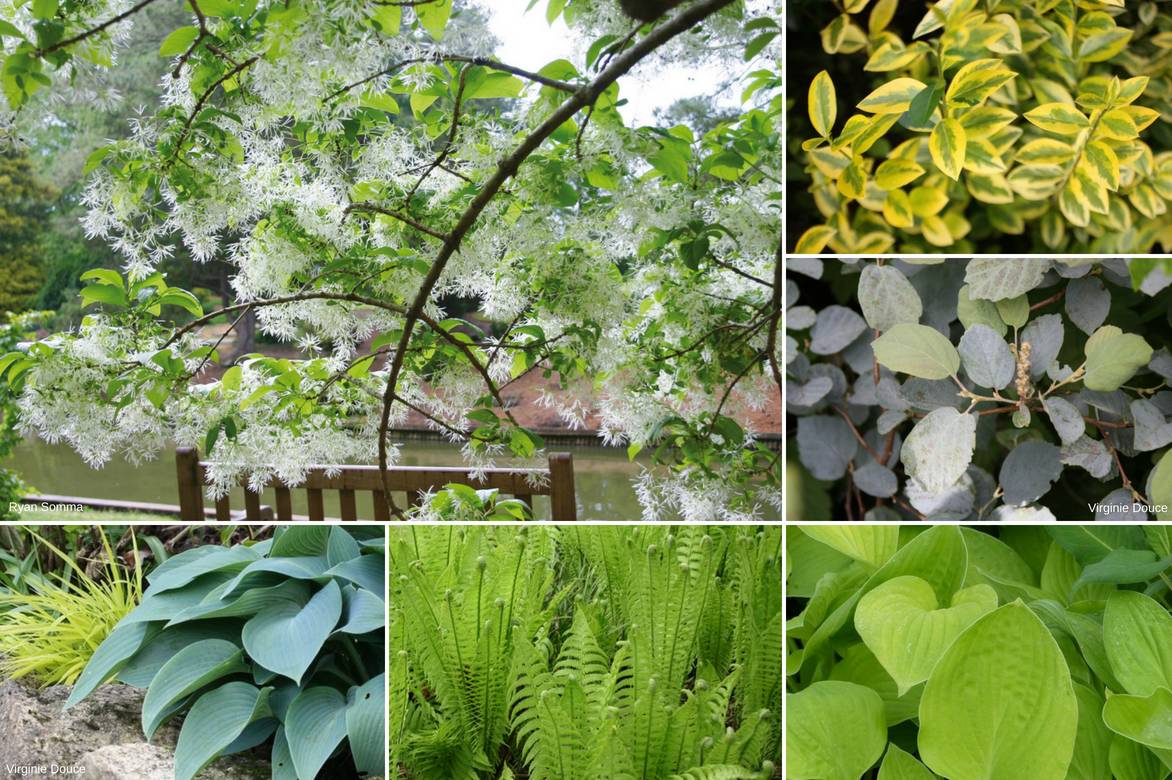
An idea for a semi-shade association: Ligustrum ovalifolium ‘Aureum’, Fothergilla intermedia ‘Blue Shadow’, Hosta ‘August Moon’, Matteuccia struthiopteris, Hakonechloa macra ‘All Gold’, Hosta ‘Halcyon’ under the cover of a Chionanthus virginicus.
The bushy privet will look stunning when combined with other trimmed shrubs, playing with the shape and colour of the foliage, in a graphic and minimalist decor on a large rockery, for example. It is also very suitable for group planting, especially on a bank that requires no maintenance.
It can be accompanied by shrubs such as Photinia, Eleagnus, St. John’s Wort, Kerria japonica, Spiraea, Physocarpus, viburnum, or by perennial plants like Daylilies, Verbena from Buenos Aires, Shrubby Sage, and Tree Lupin for a beautiful wildflower scene, thus enjoying its beautiful foliage and pleasant flowering while allowing it to develop freely.
You can also honour it by letting it grow freely, in a countryside thicket of humble shrubs that are very useful for wildlife such as viburnum lantana, laurustinus, Cotoneaster, Pyracantha, Holly, Eleagnus, deciduous or evergreen Euonymus, Physocarpus, bay laurel…

An example of a hedge association: Physocarpus ‘Lady in Red’, Ligustrum japonicum ‘Rotundifolium’, Viburnum tinus ‘Spirit’, Cotoneaster lacteus, Euonymus planipes.
Finally, don’t forget that Ligustrum lucidum quickly forms a small evergreen shade tree that is very useful to plant in Mediterranean areas in particular.
Did you know?
Berries of Ligustrum japonicum are used in phytotherapy as a cardiotonic, laxative, diuretic, and tonic.
The consumption of privet leaves by horses and ruminants is dangerous. Avoid planting them in their circulation area!
Ligustrum japonicum propagates easily by sowing and can sometimes become invasive, as seen in the United States. Its introduction in the early 19th century has led to the presence of dense undergrowth or fields that prevent native plants from growing. Moreover, its removal is difficult.
- Subscribe!
- Contents
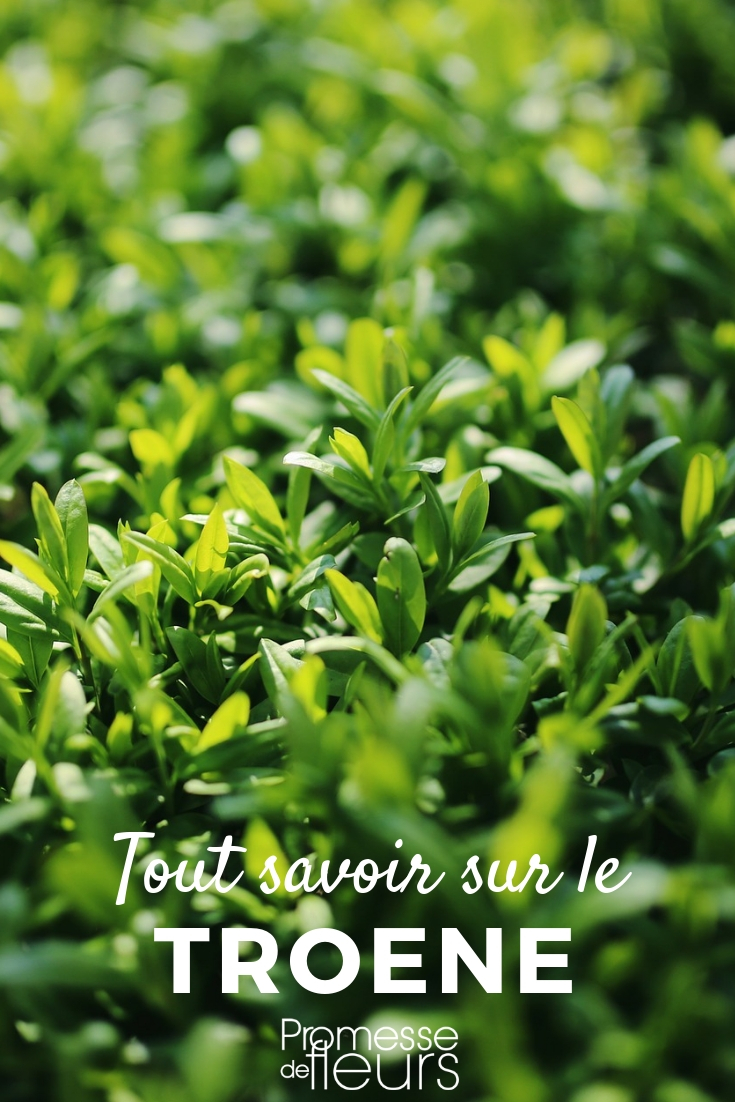


































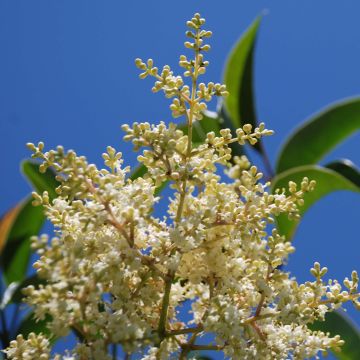
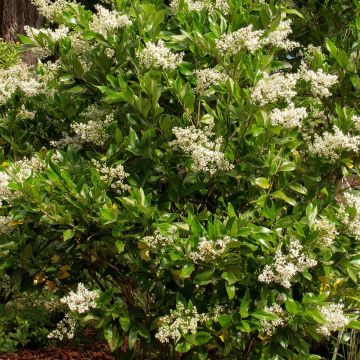
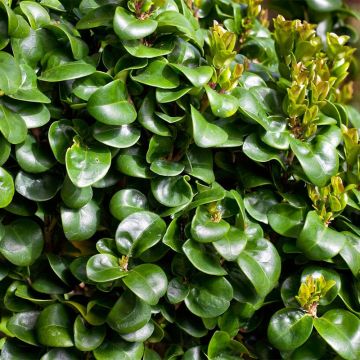


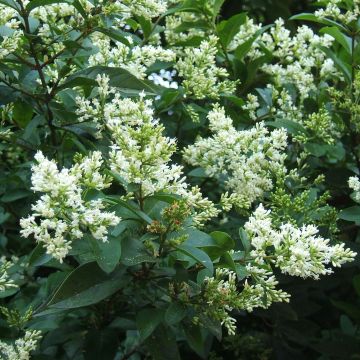

Comments